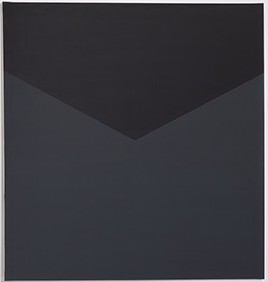
Far off-Study for Homage to the Square, 1958, Oil on hardboard, 76,3 cm x 76,3 cm
Josef ALBERS, 1888 (Germany) - 1976 (USA)
|
This German artist was born in Bottrop in 1888 and died in 1976 in the United States. After studying at the School of Fine Arts in Berlin (1913-1915) while continuing his artistic training from 1916 to 1920, Josef Albers moved towards teaching. Albers then enrolled at the Bauhaus in Weimar where he studied until 1923 before becoming a teacher himself, from 1925 onwards. This experience was a crucial part of directing the artist in his thinking. True to the spirit of Bauhaus, Josef Albers always rejected the distinction between artistic creation and design for practical objects. His work explored different domaines including painting, typography, photography as well as furniture and object design. When the Nazis closed the Bauhaus in 1933, Albers moved to America where he continued his career as head of the painting programme at Black Mountain College in North Carolina, and then later went on to head the Yale School of Art.
Josef Albers is considered as a smuggler of Bauhaus ideas, bringing them to the States, seeking to reconcile technical progress with art. He broadcast to the greatest audience and brought together the use of all types of materials, including the most modest, to create works of art. His students include some of the world’s most celebrated artists, namely Robert Rauschenberg, Cy Twombly, Kenneth Noland, Richard Anuszkiewicz and Eva Hesse. Painter, draftsman, industrial designer, theorist and photographer, Josef Albers emphasized his interest in reducing forms to their simplest expression at an early stage as well as a connection to the serial process. He stands out on the international scene thanks to his expression of colours and especially on optical and psychic phenomena that result from their association. His research is the subject of the book entitled, The Interaction of Colours, published in 1963. From a pragmatic perspective, Josef Albers exposes and demonstrates a theory that goes against colourimetry. At that time this way of thinking was strongly defended by teachers and that of his former Bauhaus colleague, Vassily Kandinsky, who gave intrinsic value to colours (an absolute value associated with symbolic resonance). Josef Albers challenged this approach, demonstrated in his study of the relationship of colours together which shows that perception of a colour is largely determined by the colours that surround it. The work presented in the exhibition belongs to the Homage to the Square series (hommage au carré), produced between 1950 to 1976, in which Josef Albers reduces his visual vocabulary to express the square. The paintings are thus comprised of three or four squares that fit into each other, making the coloured shapes less calculating. Josef Albers' study focuses on the behaviour of colours according to their extent, intensity and environment. This serial work like the majority of Josef Albers' pictorial production, ″Far Off-Study for Homage to the Square″ sits chronologically in the middle of the Homage to the Square phase. Through the details in the material, techniques and processes used, written on the back, the artist affirms the experimental and scientific nature of his approach by distinguishing each piece within the series.
Crédit photo:
|